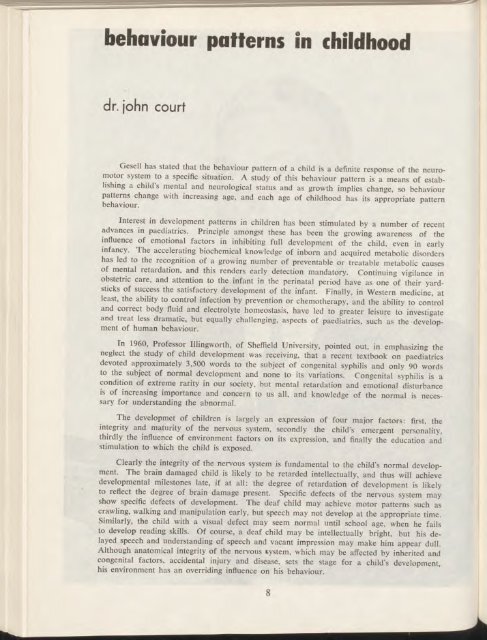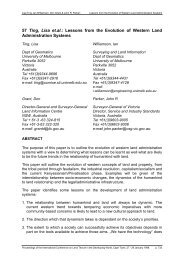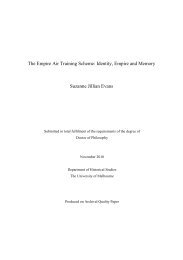Speculum - University of Melbourne
Speculum - University of Melbourne
Speculum - University of Melbourne
You also want an ePaper? Increase the reach of your titles
YUMPU automatically turns print PDFs into web optimized ePapers that Google loves.
ehaviour patterns in childhood<br />
dr. john court<br />
Gesell has stated that the behaviour pattern <strong>of</strong> a child is a definite response <strong>of</strong> the neuromotor<br />
system to a specific situation. A study <strong>of</strong> this behaviour pattern is a means <strong>of</strong> establishing<br />
a child's mental and neurological status and as growth implies change, so behaviour<br />
patterns change with increasing age, and each age <strong>of</strong> childhood has its appropriate pattern<br />
behaviour.<br />
Interest in development patterns in children has been stimulated by a number <strong>of</strong> recent<br />
advances in paediatrics. Principle amongst these has been the growing awareness <strong>of</strong> the<br />
influence <strong>of</strong> emotional factors in inhibiting full development <strong>of</strong> the child, even in early<br />
infancy. The accelerating biochemical knowledge <strong>of</strong> inborn and acquired metabolic disorders<br />
has led to the recognition <strong>of</strong> a growing number <strong>of</strong> preventable or treatable metabolic causes<br />
<strong>of</strong> mental retardation, and this renders early detection mandatory. Continuing vigilance in<br />
obstetric care, and attention to the infant in the perinatal period have as one <strong>of</strong> their yardsticks<br />
<strong>of</strong> success the satisfactory development <strong>of</strong> the infant. Finally, in Western medicine, at<br />
least, the ability to control infection by prevention or chemotherapy, and the ability to control<br />
and correct body fluid and electrolyte homeostasis, have led to greater leisure to investigate<br />
and treat less dramatic, but equally challenging, aspects <strong>of</strong> paediatrics, such as the development<br />
<strong>of</strong> human behaviour.<br />
In 1960, Pr<strong>of</strong>essor Illingworth, <strong>of</strong> Sheffield <strong>University</strong>, pointed out, in emphasizing the<br />
neglect the study <strong>of</strong> child development was receiving, that a recent textbook on paediatrics<br />
devoted approximately 3,500 words to the subject <strong>of</strong> congenital syphilis and only 90 words<br />
to the subject <strong>of</strong> normal development and none to its variations. Congenital syphilis is a<br />
condition <strong>of</strong> extreme rarity in our society, but mental retardation and emotional disturbance<br />
is <strong>of</strong> increasing importance and concern to us all, and knowledge <strong>of</strong> the normal is necessary<br />
for understanding the abnormal.<br />
The developmet <strong>of</strong> children is largely an expression <strong>of</strong> four major factors: first, the<br />
integrity and maturity <strong>of</strong> the nervous system, secondly the child's emergent personality,<br />
thirdly the influence <strong>of</strong> environment factors on its expression, and finally the education and<br />
stimulation to which the child is exposed.<br />
Clearly the integrity <strong>of</strong> the nervous system is fundamental to the child's normal development.<br />
The brain damaged child is likely to be retarded intellectually, and thus will achieve<br />
developmental milestones late, if at all: the degree <strong>of</strong> retardation <strong>of</strong> development is likely<br />
to reflect the degree <strong>of</strong> brain damage present. Specific defects <strong>of</strong> the nervous system may<br />
show specific defects <strong>of</strong> development. The deaf child may achieve motor patterns such as<br />
crawling, walking and manipulation early, but speech may not develop at the appropriate time.<br />
Similarly, the child with a visual defect may seem normal until school age, when he fails<br />
to develop reading skills. Of course, a deaf child may be intellectually bright, but his delayed<br />
speech and understanding <strong>of</strong> speech and vacant impression may make him appear dull.<br />
Although anatomical integrity <strong>of</strong> the nervous system, which may be affected by inherited and<br />
congenital factors, accidental injury and disease, sets the stage for a child's development,<br />
his environment has an overriding influence on his behaviour.<br />
8

















